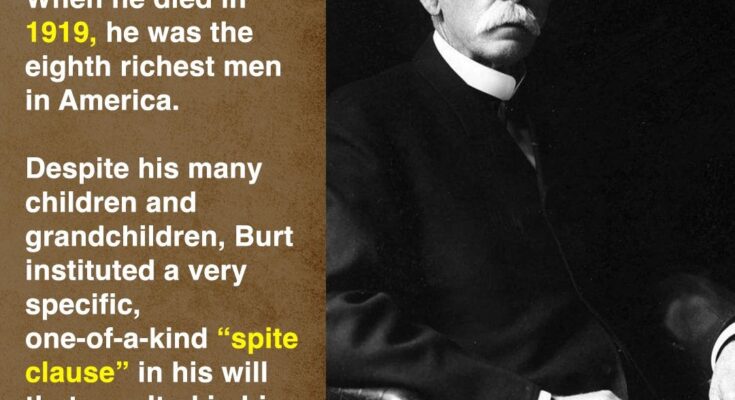When someone does you wrong, you might have the desire to get revenge – or at the very least, get the last word. Whether it’s a small evil or an egregious error, that feeling of needing to throw a bit of spite back at the other person is very real.
Payback comes in many forms, and money is certainly one way to show the world you’re not going to take it anymore. Granted, being wealthy can help you make a much larger display of dissatisfaction, but even minor money flexes can make a major point.
We found some examples of people using various amounts of money to get back at the folks they felt did them wrong. Some of the acts are kind of petty, while others are as serious as they come. Across the board, they’re all pretty relatable – to the extent that they left us saying, “Yeah, I’d do that.”
Residents Found Creative Ways To Outmaneuver Their HOAs
Some of the rules and regulations put into place by homeowners’ associations can be tedious and tiresome. Around the end of the year, many HOAs dictate the types of holiday decorations residents can display, when they can go up, and occasionally, even how much money homeowners should spend. For one Jewish individual in Oklahoma, the HOA guidelines about Christmas decorations proved especially egregious:
My HOA in Oklahoma required that you hire a professional company and spend at least $500 to put up lights at Christmas time. They threatened to fine me when I refused, so, since I’m Jewish, I got a company to put up a huge Star of David in my front yard. They removed the requirement from the HOA rules the next year.
It’s not uncommon to encounter HOA restrictions when it comes to satellite dishes and comparable devices. One resourceful man found a way to spend a little money and improvise in that regard when his HOA said he couldn’t have a satellite dish on his property. In the words of his neighbor:
So what does he do? He buys the ugliest hearse he can find, attached the satellite [dish] to it, and parks it on the street. HOA board calls the cops on cars every 24 hours (law is your vehicle has to move every 24 hours or you get a ticket/towed). So to spite them, every day he moves his hearse, with the satellite, to avoid a ticket or getting towed. And they couldn’t do anything about it.
Charles Froling Built An Obnoxious House To Get Back At His Neighbor
In a story that has literally become the stuff of legends, Charles Froling reportedly built a house on his land with the intent of irritating his neighbor. As a bonus, he could also irritate the town in which he lived. According to records, Froling built “a two-story dwelling… nine feet wide [that] shut out the sunlight from a part of” his neighbor’s house in 1908. The distinctive structure was 20 feet high, 54 feet long, and 10 feet wide.
Froling erected the abode because the city of Alameda, CA, had seized part of his land, so he put what’s now called “The Spite House” on the land he had left, with the intent of proving a point. Although he was angry at the city, his neighbor showed Froling no sympathy (and may have actually helped Alameda go after him), so the blocked sunlight was intentional.
Zoning and construction regulations forbid a house like Froling’s from being built today, but the structure still stands.
Warren Buffett Bought Berkshire Hathaway After A Lowball Offer Offended Him
In what Warren Buffett openly said was a move that involved committing “a major amount of money to a terrible business,” the businessman bought enough stock in Berkshire Hathaway in 1965 to take control of the company. His rationale was to get back at Seabury Stanton, who ran Berkshire Hathaway at the time.
In 1964, Stanton made a verbal promise to buy Buffett’s stock in Berkshire Hathaway at $11.50 per share. When the written offer came in, however, Stanton proposed $11 3/8 or, in Buffett’s words:
He chiseled me for an eighth… If that letter had come through with 11 ½, I would have tendered my stock. But this made me mad. So I went out and started buying the stock, and I bought control of the company and fired Mr. Stanton.
As far as money moves go, the potentially bad purchase eventually paid off for Buffett – but not right away. While he expanded the business from textiles and entered the insurance industry in 1967, had he made that move sooner, “Berkshire would be worth twice as much as it is now.”
Mariya Oktyabrskaya Sold Her Possessions To Buy A Tank And Fight In WWII
The demise of her husband, Ilya, was the last straw for Mariya Oktyabrskaya. Born in 1905 in Ukraine, Oktyabrskaya took an interest in tanks two years after the death of Ilya – when she was finally informed of his passing. In 1943, she donated the money she had to the Red Army, asking that they make a T-34 tank she could use on the battlefield. In the letter she sent, Oktyabrskaya wrote:
My husband was killed in action defending the motherland. I want revenge on the fascist dogs for his death and for the death of Soviet people tortured by the fascist barbarians. For this purpose I’ve deposited all my personal savings – 50,000 rubles – to the National Bank in order to build a tank. I kindly ask to name the tank “Fighting Girlfriend” and to send me to the frontline as a driver of said tank.
The Kremlin agreed.
Oktyabrskaya undertook tank training, fought for the first time in the autumn of 1943, and participated in her last military action in January 1944. During her time on the battlefield, she reportedly demonstrated herself to be skilled at maneuvering her vehicle against the enemy. After her tank was damaged on a night mission on January 14, 1944, she disobeyed orders and tried to fix it. Oktyabrskaya was either shot or hit by shrapnel and succumbed to her injuries two months later.
‘Tom’ Guo Opened Up A Spite Store To Really Make A Point
The idea of a “spite store” (inspired by real events) was front and center during season 10 of the long-running HBO sitcom Curb Your Enthusiasm. When Larry David opens his coffee shop, Latte Larry’s, it’s to get back at Mocha Joe’s, an establishment that banned David for being too critical. In the show, several additional spite stores pop up, including Sean’s Exotic Birds (owned by Sean Penn after the rival store, Ray’s, sold him a mute bird). Other spite stores were owned by Jonah Hill (who opened a deli to avenge a hairy sandwich) and Mila Kunis (who drove a jewelry store out of business by opening a comparable one next door).
It might seem extreme, but there are real examples of spite stores – businesses developed to specifically take on another establishment. One example is Tom’s Dim Sum Mania in Media, PA. Opened by Jintao “Tom” Guo in 2019, it was just two doors down from another dumpling – Tom’s Dim Sum. Guo used to be business partners with the owner of Tom’s Dim Sum, but, as he expresses it, “people use your name, then take you out.”
The battle of the dim sum shops resulted in a lawsuit over naming rights. Tom’s Dim Sum accused Guo of opening and operating:
…a restaurant under the name of “Tom’s Dim Sum Mania” only approximately 20 feet from [Tom’s Dim Sum], which services and offers the same type of food… for the deliberate purpose of misleading, deceiving and defrauding the public as well as stealing away [Tom’s Dim Sum’s] business unfairly and diverting [Tom’s Dim Sum’s] customers to “Tom’s Dim Sum Mania.”
Robert Edleston Erected A 40-Foot Column To Overshadow The Cemetery Next Door
When the family of Joseph Edleston, a former vicar at St. Mary’s Church in Ganiford, England, requested a monument be put up in his honor in the church’s cemetery, the religious house declined. They actually suggested the Edleston family donate land – which ran next to the cemetery – for a monument instead.
Rather than do this, the family built a large house on that land – another so-called spite house – but they didn’t stop there. In 1923, Robert Edleston put up a 40-foot column that he’d purchased right next to the cemetery wall.
The column dated to roughly 1750, was initially built to commemorate the end of the War of the Austrian Succession, and had long since lost the statue that once accompanied it. Considering the house was built in 1904 and the column was added nearly two decades later, the introduction of the latter was presumably a sign of continued animus.
John McCaffrey’s Ex-Wife And Mistress Teamed Up To Buy Him One Last Gift
Speculation about the authenticity of John McCaffrey’s headstone has circulated for many years, but it is real. The story behind how it came to be made is a bit mysterious, but it could very well have been purchased out of spite.
McCaffrey passed in 1995 and is buried in the Notre-Dame-Des-Neiges Cemetery in Montreal, Quebec, Canada. The front of the headstone bears his name and the years of his life. The back has a unique epitaph:
John:
Free your body and soul
Unfold your powerful wings
Climb up the highest mountains
Kick your feet up in the air
You may now live forever
Or return to this earth
Unless you feel good where you are!Missed by your friends
Activists Bought A House And Some Paint To Take On Hate
In 2013, Aaron Jackson bought a bungalow across the street from Westboro Baptist Church in Topeka, KS. Living in Florida at the time, the activist took possession of what is now called Equality House. Surrounded by members of the church, Jackson and several volunteers set out to distinguish themselves in the conservative neighborhood.
Jackson and friends painted the outside of the house to look like a rainbow – also a symbol of the LGBTQ community. In 2018, he explained to CBC Radio:
I let people see it how they want to see it. Some people just see it as funny, like a middle finger to the WBC. Some people see it as something more… When we painted the house, I didn’t know how the community was going to react. I was very nervous about that… People often think it looks like the North Korea – South Korea border. That we have missiles pointed at each other, ready to blow each other up. And that couldn’t be any further from the truth.
Generally, Jackson says he and his neighbors “definitely represent two different ideals… [but] actually get along pretty well once we got to know each other, to see each other as people.”
Money And Revenge Were Practically Synonymous For Robber Barons
Andrew Carnegie and Henry Clay Frick had a long business relationship, one that was solidified when they became partners in 1882. Frick, the owner of Frick Coke Company, became chairman of Carnegie Steel in 1889 and became the “bad cop” of the business. He actively worked against efforts to organize labor and was behind the violent outcome of the Homestead Strike of 1892.
Carnegie’s and Frick’s personalities clashed, and in 1899, Frick resigned from the board. The two powerhouses then entered into a legal battle over Frick’s stock, one that made Frick an even wealthier man. Carnegie had essentially paid to make Frick go away – $31 million, to be exact – but he didn’t. He instead decided to team up with J.P. Morgan and served as one of the directors of United States Steel Corporation in 1901. It was in this role that Frick helped negotiate Morgan’s buyout of Carnegie Steel for a price he hoped would bring about the “elimination of Mr. Carnegie.”
What brought Carnegie and Frick together in the first place, however, was Carnegie’s desire to surpass J.D. Rockefeller in wealth. Carnegie blamed Rockefeller for the death of Thomas Scott, his mentor.
As the owner of Standard Oil, Rockefeller began to use his own pipelines to move oil instead of relying on railroads. Scott, president of Pennsylvania Railroad, had a stroke in 1878 – on the heels of the Great Railroad Strike of 1877. The strike was due to pay cuts and job losses that were, in part, the result of Rockefeller’s changing relationship with the railroads. In the end, Scott had no choice but to ally with Rockefeller, which ultimately made the oil magnate more powerful.
A Michigan Tycoon Wrote His Will To Keep His Children – And Grandchildren – From Claiming His Money
When he died in 1919, Michigan lumber tycoon Wellington Burt was considered “one of the eight wealthiest men in America,” and the absolute wealthiest in the history of Saginaw, MI. However, his will ensured that neither his children nor his grandchildren would ever see a penny of his vast fortune.
The will included a “spite clause” that demanded his money be put into a trust that could not be opened until 21 years after the death of his last surviving grandchild. That grandchild, Marion Lansill, passed in November 1989, so the fortune remained untouched until 2010. By that time, the accrued interest had ballooned Burt’s savings to over $100 million.
Why Burt kept the majority of his money from his relatives is unknown. The Guardian offers only two points of speculation: It was either due to “petty gripes against family members” or he was just a “sour old man who wanted to wreak his revenge beyond the grave.” He didn’t leave his kids with nothing, though. They were given a yearly allowance of $1,000 a year – the same sum he left his household staff.
Elon Musk Didn’t Like Twitter’s Policies, So He Decided To Buy The Platform
In April 2022, entrepreneur Elon Musk agreed to purchase the social media platform Twitter for $44 billion. The move came after a long line of criticisms from the Tesla co-founder about Twitter’s policies on harassment, abuse, and posts about potential physical harm. Musk, a self-described “free speech absolutist,” views Twitter as “the digital town square where matters vital to the future of humanity are debated.”
Musk himself has been subject to criticism for his use of Twitter, notably by the US Securities and Exchange Commission (SEC). After he tweeted statements about Tesla, the SEC determined in 2018 that some of Musk’s tweets about his company needed vetting by lawyers before being posted. In 2020, Musk’s tweets about COVID-19 received attention for misleading claims, while the SpaceX CEO continues to regularly antagonize individuals he doesn’t agree with on the platform.
Musk’s offer to buy Twitter was anything but straightforward. On May 17, 2022, Musk tweeted that the number of “fake/spam accounts” on Twitter was four times more than what the platform filed with the SEC. He continued,
Twitter’s CEO publicly refused to show proof of <5%. This deal cannot move forward until he does.
For his part, Twitter CEO Parag Agrawal tweeted, “Our estimate is based on multiple human reviews of thousands of accounts that are sampled at random, consistently over time.”
As of May 2022, the outcome of the Twitter deal remained unclear, but the sale went through in October of the same year.













